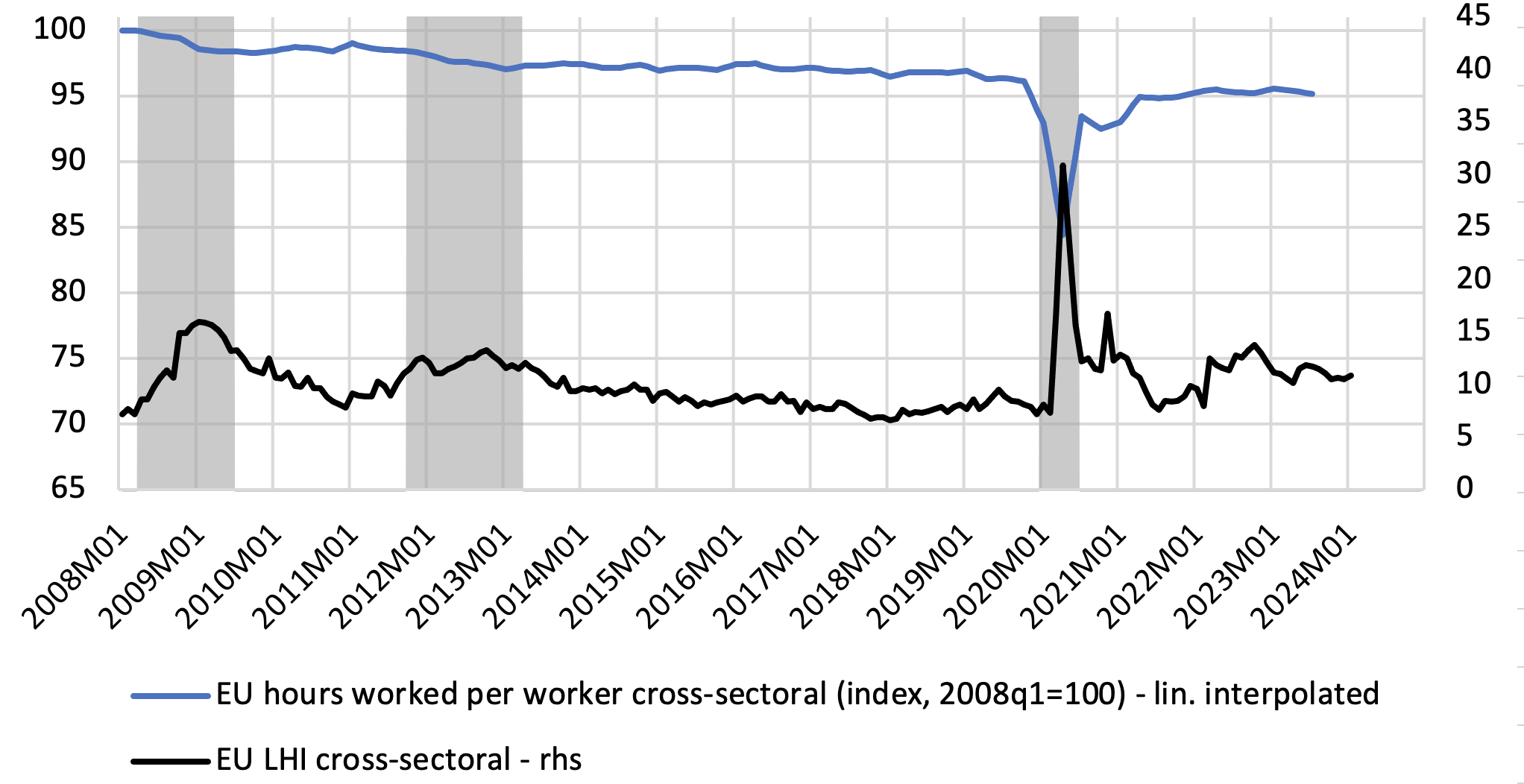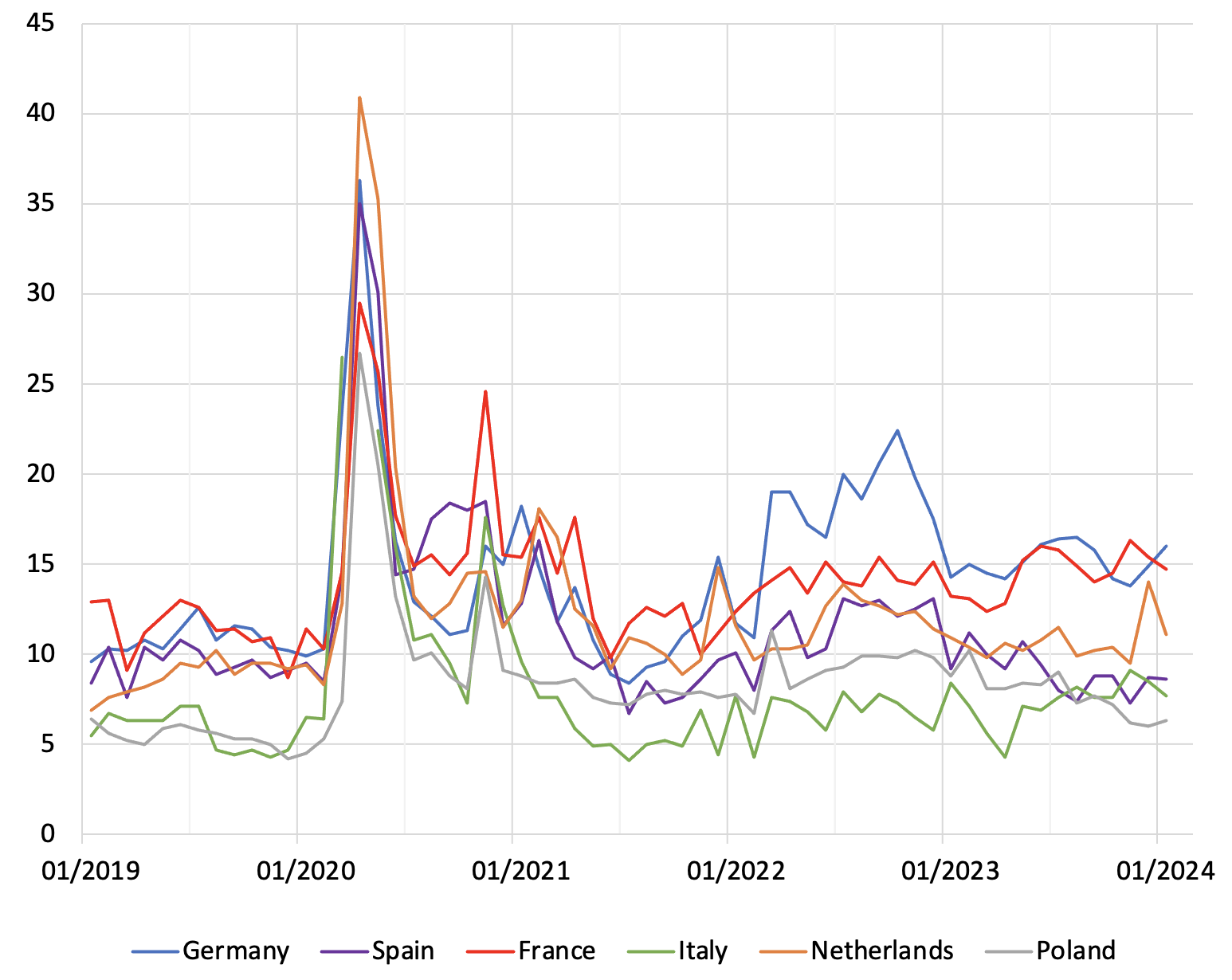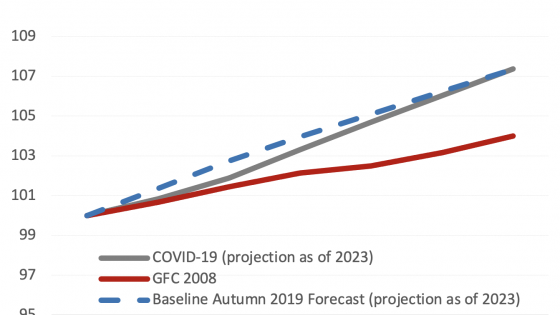Despite facing a period of protracted slow growth since the second half of 2022, the EU labour market has shown a high degree of resilience. Following a temporary surge in the first months of the COVID-19 pandemic, unemployment in the EU quickly declined. Throughout 2022 and 2023, it has been as low as never before and the EU labour market reached unprecedented levels of tightness (see Figure 1), which seems to be associated more with growing labour demand than falling labour supply or mismatches (European Commission 2023a).
Figure 1 EU job vacancy rate and shortage of labour as a factor limiting production (%)
Notes: The job vacancy rate reports the proportion of total posts that are vacant. The time-series on factors limiting production refer to the percentage of surveyed firms reporting a shortage of labour as a factor limiting their production/business activity. In the case of construction, the reported scores are quarterly averages of the monthly survey results.
Data Sources: Eurostat, Directorate-General for Economic and Financial Affairs of the European Commission
The persistent labour shortages have induced firms to cling to their employees, in an attempt to ensure against costly recruitment of new staff once growth picks up (European Commission 2023a, Arce et al. 2023). This 'labour hoarding’ practice has further tightened the labour market, resulting in a situation where “tightness begets tightness” (Doornik et al. 2023).
Monitoring the extent of labour hoarding is crucial…
Properly gauging the prevalence of labour hoarding in the EU economy is highly relevant at the current juncture. First, labour hoarding stabilises aggregate labour demand. However, the longer it is practised in the presence of sluggish growth, the higher the likelihood that firms will run out of steam and will need to lay workers off (Schnabel 2023). The presence of entrenched labour hoarding is thus a downward risk for the performance of the EU labour market going forward.
Second, labour hoarding is a form of labour underutilisation and thus has a negative effect on productivity growth. At the same time, by reinforcing shortages on the labour market, it strengthens employees’ wage bargaining power and thus exerts upward pressure on wages. The resulting increase in unit labour costs bears the risk of fuelling inflation and could trigger a wage-price spiral. The extent of labour hoarding thus has an important bearing on whether the ECB’s projected decline in core inflation will materialise (Schnabel 2023).
…but there are no direct measures of it
In spite of the relevance of labour hoarding to properly understand labour market dynamics, there are no direct (statistical) measures of it, only ‘proxies’. The most frequently used are labour productivity per person (i.e. output per head) and average hours worked per worker. The disadvantage of both is that they are not purely cyclical indicators, but are also driven by structural developments. Labour productivity is an imperfect measure of labour utilisation as it also reflects changes in the capital stock (and its utilisation), the rate of technological progress, the skill composition of the labour force and the degree of competition in the final goods market. Hours worked per worker follow a structural downward trend which reflects, inter alia, a growing share of part-time work (Botelho et al. 2021).
European Commission launches survey-based Labour Hoarding Indicator
In view of this gap in the analytical tool kit, the European Commission has developed a new monthly Labour Hoarding Indicator (LHI) measuring the degree of labour underutilisation in the economy. The indicator is based on the Commission’s Joint Harmonised EU Programme of Business and Consumer Surveys (BCS) and combines the answers of managers to two existing survey questions regarding their expectations with respect to employment and output over the next three months. The indicator reports the (weighted) percentage of companies which expect their output to decrease, but their employment to remain stable or even increase.
Combining results for survey questions which were already collected under the BCS Programme for many years, the LHI could be constructed backwards in time, creating long time series. This allows for meaningful interpretations of its current scores against long-term developments and its use in economic time-series analyses.
The LHI is available for all EU Member States and five candidate countries, as well as the EU and euro area as a whole, both at sectoral (industry, services, retail trade, construction) and cross-sectoral (economy-wide) level. New monthly data are released at the end of every month and can be downloaded from the EU BCS Website.
A purely cyclical measure of labour underutilisation
The new LHI shows a convincing performance as a cyclical measure of labour underutilisation, as illustrated by Figure 2, which plots the EU cross-sectoral aggregate of the indicator against the backdrop of the economic cycle (with recessions highlighted as grey shaded areas) and alongside hours worked per worker.
Figure 2 EU (cross-sectoral) LHI and hours worked per worker
Notes: The shaded areas reported in the graph represent technical recessions corresponding to at least two quarters of negative (quarter-on-quarter) GDP growth. The Eurostat national accounts dataset contains information on total employment and total hours worked. Hours worked per worker are obtained by dividing total hours worked by total employment.
Data Sources: Eurostat, Directorate-General for Economic and Financial Affairs of the European Commission.
As expected, the LHI peaks in each of the three recessions shown in the graph. The magnitude of the peak is much bigger in the recession caused by the COVID-19 pandemic than in the preceding two recessions, which is plausible in the light of the sharper contraction of GDP and the more widespread use of state-subsidised short-time working schemes during the pandemic (Anderton et al. 2020).
The evolution of the LHI also tallies with that of hours worked per worker. In particular, as hours worked rebound sharply from their COVID-19 trough, the LHI plummets. A comparison of the two indicators also highlights the clear cyclical nature of the LHI. After each peak the indicator sinks back to its pre-crisis level. This makes its interpretation easier than for the average hours worked variable, which is driven by both cyclical (=labour utilisation) and structural developments (downward trend due to growing share of part-time work, etc.). As shown in Figure 2, every recession results in a permanent decline in average hours worked and whether (and at what point in time) recession-induced labour hoarding can be assumed to have stopped depends crucially on how the long-term trend is specified.
LHI points to vulnerabilities of the EU labour market
As shown in Figure 2, labour hoarding has been at an elevated level for the last two years and thus constitutes a source of vulnerability of the EU labour market going forward. Zooming into the largest EU economies (Figure 3), the risks appear particularly high in Germany, France and, to a lesser extent, the Netherlands, where more than 10% of companies are hoarding labour. By contrast, the tally is below 10% in Italy, Spain and Poland. The divergence is in line with the different (quarter-on-quarter) growth rates of the countries in the third and fourth quarter of last year: while GDP was flat or declining in Germany, France and the Netherlands, it increased in Italy, Spain, and, particularly, Poland.
When taking a longer-term perspective, the structurally lower levels of labour hoarding in Italy and Spain chime with the observation of lower labour market tightness as measured by the percentage of firms reporting their production/activity to be limited by a shortage of labour (European Commission 2022). Apart from the country-specific level, the LHI also produces intuitive results at the sector-specific level (industry, services, retail trade, construction; see European Commission 2023b).
Figure 3 Labour hoarding in the largest six EU economies
The cross-country perspective is also central for the EU’s economic and fiscal policy coordination of Member States (e.g. Mc Morrow et al. 2021, Thum-Thysen et al. 2022). In this context, preliminary analyses point to the usefulness of the new labour hoarding indicators for the estimation of the non-accelerating wage rate of unemployment (NAWRU), which feeds into the estimation of output gaps (Croitorov et al. 2023). Labour hoarding is a cyclical phenomenon and should not affect structural unemployment (the NAWRU). However, labour hoarding leads to temporarily lower productivity per worker and, hence, higher unit labour costs. In the European Union's Commonly Agreed Methodology (EU-CAM) for the estimation of potential growth and output gaps, this would, in turn, drive up the NAWRU estimates. By properly accounting for labour hoarding in the estimation of the NAWRU, this upward bias can be filtered out and the corresponding downward bias in potential growth estimates based on the NAWRU can be avoided.
Conclusions
The European Commission’s new Labour Hoarding Indicator allows close monitoring of labour market developments due to its monthly and quasi real-time availability. Compared to previously available proxies of labour hoarding, the new indicator has the advantage that it measures purely cyclical developments on the labour market.
The new LHI indicates that labour hoarding has been at an elevated level for the last two years and thus constitutes a source of vulnerability of the EU labour market going forward. Amongst the largest EU economies, the risks appear particularly pronounced in Germany, France and, to a lesser extent, the Netherlands.
Apart from monthly monitoring purposes, the indicator could improve the estimation of key variables in the Commission’s annual and medium-term economic surveillance work, such as the non-accelerating wage rate of unemployment, which has a direct bearing on the estimation of output gaps.
Authors’ note: The authors would like to sincerely thank Atanas Hristov for his inspiration and invaluable advice and work on building the labour hoarding indicator and the national partners in the joint harmonised EU Programme of Business and Consumer Surveys (BCS) who have participated in the pilot studies leading to the integration of the indicator in the official EU-BCS framework.
References
Anderton, R, V Botelho, A Consolo, A Dias da Silva, C Foroni, M Mohr and L Vivian (2020), “The impact of the COVID-19 pandemic on the euro area labour market”, ECB Economic Bulletin, Issue 8/2020.
Arce, O, A Consolo, A Dias da Silva, M Mohr (2023), “More jobs but fewer working hours”, The ECB Blog, 7 June 2023.
Botelho, V, A Consolo and A Dias da Silva (2021), “Hours worked in the euro area”, ECB Economic Bulletin, Issue 6/2021.
Croitorov, O, A Reuter, A Thum-Thysen (2023, December 18–19). “Structural unemployment and a new survey-based labour hoarding indicator”, poster presented at the “Workshop on Macroeconomics and Survey Data”, National Bank of Belgium, Brussels, Belgium.
Doornik, B, D Igan, E Kharroubi (2023), “Labour markets: what explains the resilience?”, BIS Quarterly Review, December.
European Commission (2022), “A closer look at labour shortages across the EU”, European Business Cycle Indicators, 3rd quarter 2022.
European Commission (2023a), “Persistent labour market tightness during a slowdown: a reappraisal of drivers”, European Economic Forecast, Autumn 2023.
European Commission (2023b), “A new survey-based labour hoarding indicator”, European Business Cycle Indicators 2023q2, July.
Mc Morrow, K, A Thum-Thysen, C Maier, A Hristov, B Döhring, F D’Auria, F Blondeau (2021), “Output gaps, potential output and the Covid-19 crisis: Policymaking under uncertainty”, VoxEU.org, 10 December.
Schnabel, I (2023), “Keynote speech at the annual Homer Jones Memorial Lecture”, November 2023.
Thum-Thysen, A, F Blondeau, F d’Auria, B Döhring, A Hristov, K Mc Morrow (2022), “Potential output and output gaps against the backdrop of the COVID-19 pandemic”, Quarterly Report on the Euro Area (QREA) 21(1): 21-30, Directorate General Economic and Financial Affairs, European Commission.










